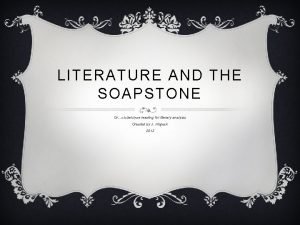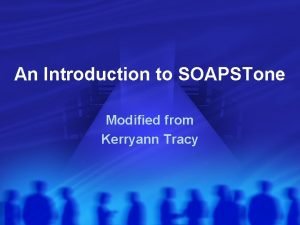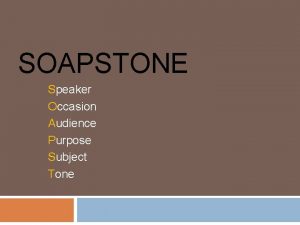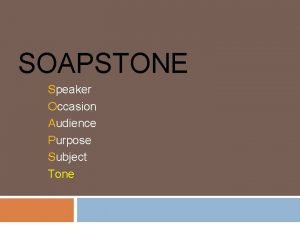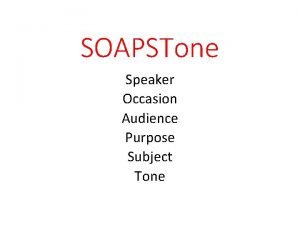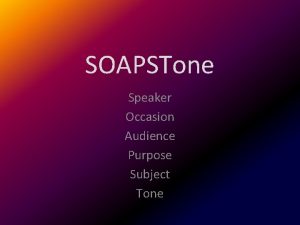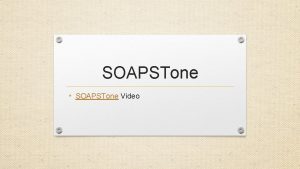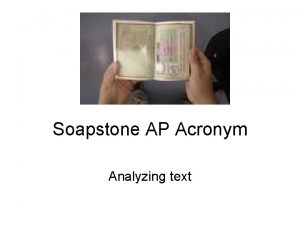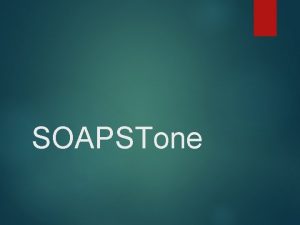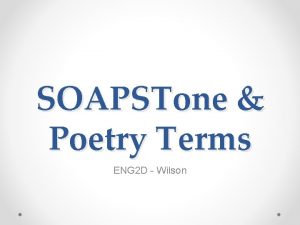LITERATURE AND THE SOAPSTONE Orclozeclose reading for literary
















- Slides: 16

LITERATURE AND THE SOAPSTONE Or…cloze/close reading for literary analysis Created by J. Krajeck 2012

SUBJECT? v Without referring to the title, you and your partner, will identify the subject of this text, using NO MORE than FIVE words! v Point out what words or phrases lead to the identification of the SUBJECT of this piece of text? In other words, “What makes you think so? ” v (Highlight those hints/clues that support your response. )

OCCASION v Why do you think the author created this piece of text? v What makes you think so? v (Highlight the clues/hints that support your response. )

v Would any of these highlighted “clues” be considered “persuasive” words? Why? v What would be the “dictionary” definition of these words? v Identify whether these words have a positive or negative feeling?

WORDS THAT HAVE FEELING v Words that take on either a positive or negative feeling, beyond their dictionary definitions, are known as connotative words. v Search for any other words in this text that may have connotative meanings (meanings beyond the dictionary definition).

AUDIENCE v Movies, TV commercials, songs, books, newspapers, magazines, visual art, etc. , all are created with a particular audience in mind. In other words, these pieces are created to appeal to specific people. v Reread this piece of text and decide who the audience is? v What makes you think so?

PURPOSE v Suppose you must Twitter your friends about the content of this text. Using NO MORE than 140 characters, create a “tweet” to your friends, appealing to them, of course, about the purpose behind this text. (In other words, what is the intended meaning behind this piece of text? ) v Include a # (hashtag) in your tweet that would identify the “audience” for those interested in responding.

SPEAKER? v If we don’t have a picture of the writer of this piece of text, how could we determine something about him or her? v Using only text evidence, DRAW a physical likeness of this author! v What words/phrases did you use as clues to your depiction? v When you send an email or text message to a friend, how might you let your friend identify you WITHOUT your real name? v Do you have a Twitter “handle, ” for instance? Nickname?

TONE…IT’S AN ATTITUDE v With a partner, read aloud ONE sentence from this piece of text. v Use both your VOICE and your GESTURES to reflect the feeling you have for the purpose of this piece of text.

QUICK WRITE…IT’S A FEELING, TOO! v Using Game Day Ready writing skills, in ONE creative sentence, reflect your personal TONE about the SOAPSTone exercise we just completed! v Use TWO “connotative” words and TWO types of punctuation (commas, dashes, parentheses, quotation marks, period, and/or exclamation marks) to reflect your TONE to your AUDIENCE of your PEERS.

THE NEXT STEP IN THE SOCRATIC PROCESS Now it’s time for teachers to employ the Socratice “deep” questions, perhaps using advice from Morimor Adler: v What does it say? (factual) v What does it mean? (interpretive) v Is it true? (evaluative. . . does it have meaning for YOU? )

SAMPLES OF DEEP, OPENENDED QUESTIONS… v Where does bias occur on the part of Jurgis? The author? v How would the Meat Industry (or any “big business” today) feel about the view that Jurgis presents? v Suggest three or four other points of view that Jurgis and /or Sinclair (author) ignore. v * As always…Cite EVIDENCE for views.

“PLAY IT (AGAIN), SAM. ” v BTW, you are too young to recognize, probably, this “idiom”; however, what do YOU think it means…and why do you think I used it now? v (You could use http: //www. phrases. org to research idioms!)

NEW TEXT…NONFICTION! v Your teacher is now going to give you a nonfiction piece of text or a lovely/cute/clever picture or piece of artwork or a music video or a carton of Ben and Jerry’s ice cream (empty, of course), and you are going to SOAPSTone it, using a repeat of this Power Point!

QUICK WRITE! v Yes, again, using the previous directions for a Game Day Ready piece of writing, do a Quick Write on the new nonfiction piece! v Why? Because brain research declares that humans need repetitive action (7 times or more) before we can finally capture and KEEP a skill! So…let the SOAPSToning continue!

OMT! v (BTW, OMT is internet slang for…ONE MORE TIME!) v Those of you who are “voluntary” readers, you do SOAPSToning naturally, everytime you read or view something. v However, those of us who are “forced” readers, i. e. , who only read when someone forces us to read, MUST practice the ART of SOAPSToning…and SOAPSToning also keeps us AWAKE!
 Pre reading while reading and post reading activities
Pre reading while reading and post reading activities Soapstone audience example
Soapstone audience example Soapstone writing strategy
Soapstone writing strategy Omt slang
Omt slang Didls example
Didls example Occasion soapstone meaning
Occasion soapstone meaning Soapst chart
Soapst chart What does subject mean in soapstone
What does subject mean in soapstone Poetic devices vs literary devices
Poetic devices vs literary devices What are the aims of teaching reading
What are the aims of teaching reading Types of reading skills in communication
Types of reading skills in communication Real definition of extensive reading
Real definition of extensive reading Intensive reading and extensive reading
Intensive reading and extensive reading Intensive reading definition
Intensive reading definition Ap spanish lit themes
Ap spanish lit themes Kontinuitetshantering
Kontinuitetshantering Novell typiska drag
Novell typiska drag



